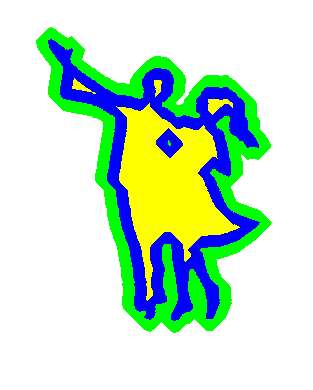|
Opening (morphology)
In mathematical morphology, opening is the dilation of the erosion of a set A by a structuring element B: :A\circ B = (A\ominus B)\oplus B, \, where \ominus and \oplus denote erosion and dilation, respectively. Together with closing, the opening serves in computer vision and image processing as a basic workhorse of morphological noise removal. Opening removes small objects from the foreground (usually taken as the bright pixels) of an image, placing them in the background, while closing removes small holes in the foreground, changing small islands of background into foreground. These techniques can also be used to find specific shapes in an image. Opening can be used to find things into which a specific structuring element can fit (edges, corners, ...). One can think of ''B'' sweeping around the inside of the boundary of ''A'', so that it does not extend beyond the boundary, and shaping the ''A'' boundary around the boundary of the element. Properties * Opening is idempotent ... [...More Info...] [...Related Items...] OR: [Wikipedia] [Google] [Baidu] |
Opening
Opening may refer to: * Al-Fatiha, "The Opening", the first chapter of the Qur'an * The Opening (album), live album by Mal Waldron * Backgammon opening * Chess opening * A title sequence or opening credits * , a term from contract bridge * , a term from contract bridge * Grand opening of a business or other institution * Hole * Inauguration * Keynote * Opening (morphology), a morphological filtering operation used in image processing * Opening sentence * Opening statement, a beginning statement in a court case * Overture * Salutation (greeting) * Vernissage A vernissage (from French, originally meaning " varnishing") is a preview of an art exhibition, which may be private, before the formal opening. If the vernissage is not open to the public, but only to invited guests, it is often called a ''pri ... See also * * {{disambig ... [...More Info...] [...Related Items...] OR: [Wikipedia] [Google] [Baidu] |
Mathematical Morphology
Mathematical morphology (MM) is a theory and technique for the analysis and processing of geometrical structures, based on set theory, lattice theory, topology, and random functions. MM is most commonly applied to digital images, but it can be employed as well on graphs, surface meshes, solids, and many other spatial structures. Topological and geometrical continuous-space concepts such as size, shape, convexity, connectivity, and geodesic distance, were introduced by MM on both continuous and discrete spaces. MM is also the foundation of morphological image processing, which consists of a set of operators that transform images according to the above characterizations. The basic morphological operators are erosion, dilation, opening and closing. MM was originally developed for binary images, and was later extended to grayscale functions and images. The subsequent generalization to complete lattices is widely accepted today as MM's theoretical foundation. History Mathemati ... [...More Info...] [...Related Items...] OR: [Wikipedia] [Google] [Baidu] |
Dilation (morphology)
Dilation (usually represented by ⊕) is one of the basic operations in mathematical morphology. Originally developed for binary images, it has been expanded first to grayscale images, and then to complete lattices. The dilation operation usually uses a structuring element for probing and expanding the shapes contained in the input image. Binary dilation In binary morphology, dilation is a shift-invariant (translation invariant) operator, equivalent to Minkowski addition. A binary image is viewed in mathematical morphology as a subset of a Euclidean space R''d'' or the integer grid Z''d'', for some dimension ''d''. Let ''E'' be a Euclidean space or an integer grid, ''A'' a binary image in ''E'', and ''B'' a structuring element regarded as a subset of R''d''. The dilation of ''A'' by ''B'' is defined by ::A \oplus B = \bigcup_ A_b, where ''A''''b'' is the translation of ''A'' by ''b''. Dilation is commutative, also given by A \oplus B = B\oplus A = \bigcup_ B_a. If ''B'' ... [...More Info...] [...Related Items...] OR: [Wikipedia] [Google] [Baidu] |
Erosion (morphology)
Erosion (usually represented by ⊖) is one of two fundamental operations (the other being dilation) in morphological image processing from which all other morphological operations are based. It was originally defined for binary images, later being extended to grayscale images, and subsequently to complete lattices. The erosion operation usually uses a structuring element for probing and reducing the shapes contained in the input image. Binary erosion In binary morphology, an image is viewed as a subset of a Euclidean space \mathbb^d or the integer grid \mathbb^d, for some dimension ''d''. The basic idea in binary morphology is to probe an image with a simple, pre-defined shape, drawing conclusions on how this shape fits or misses the shapes in the image. This simple "probe" is called structuring element, and is itself a binary image (i.e., a subset of the space or grid). Let ''E'' be a Euclidean space or an integer grid, and ''A'' a binary image in ''E''. The erosion of the ... [...More Info...] [...Related Items...] OR: [Wikipedia] [Google] [Baidu] |
Set (mathematics)
A set is the mathematical model for a collection of different things; a set contains '' elements'' or ''members'', which can be mathematical objects of any kind: numbers, symbols, points in space, lines, other geometrical shapes, variables, or even other sets. The set with no element is the empty set; a set with a single element is a singleton. A set may have a finite number of elements or be an infinite set. Two sets are equal if they have precisely the same elements. Sets are ubiquitous in modern mathematics. Indeed, set theory, more specifically Zermelo–Fraenkel set theory, has been the standard way to provide rigorous foundations for all branches of mathematics since the first half of the 20th century. History The concept of a set emerged in mathematics at the end of the 19th century. The German word for set, ''Menge'', was coined by Bernard Bolzano in his work ''Paradoxes of the Infinite''. Georg Cantor, one of the founders of set theory, gave the following defin ... [...More Info...] [...Related Items...] OR: [Wikipedia] [Google] [Baidu] |
Structuring Element
In mathematical morphology, a structuring element is a shape, used to probe or interact with a given image, with the purpose of drawing conclusions on how this shape fits or misses the shapes in the image. It is typically used in morphological operations, such as dilation, erosion, opening, and closing, as well as the hit-or-miss transform. According to Georges Matheron, knowledge about an object (e.g., an image) depends on the manner in which we probe (observe) it.See ( Dougherty 1992), chapter 1, page 1. In particular, the choice of a certain structuring element for a particular morphological operation influences the information one can obtain. There are two main characteristics that are directly related to structuring elements: * Shape. For example, the structuring element can be a "ball" or a line; convex or a ring, etc. By choosing a particular structuring element, one sets a way of differentiating some objects (or parts of objects) from others, according to their shape or spa ... [...More Info...] [...Related Items...] OR: [Wikipedia] [Google] [Baidu] |
Closing (morphology)
In mathematical morphology, the closing of a set (binary image) ''A'' by a structuring element ''B'' is the erosion (morphology), erosion of the dilation (morphology), dilation of that set, :A\bullet B = (A\oplus B)\ominus B, \, where \oplus and \ominus denote the dilation and erosion, respectively. In image processing, closing is, together with opening (morphology), opening, the basic workhorse of morphological signal noise, noise removal. Opening removes small objects, while closing removes small holes. Properties * It is idempotent, that is, (A\bullet B)\bullet B=A\bullet B. * It is increasing, that is, if A\subseteq C, then A\bullet B \subseteq C\bullet B. * It is ''extensive'', i.e., A\subseteq A\bullet B. * It is Translational invariance, translation invariant. See also *Mathematical morphology *Dilation (morphology), Dilation *Erosion (morphology), Erosion *Opening (morphology), Opening *Top-hat_transform, Top-hat transformation Bibliography * ''Image Analysis and Mat ... [...More Info...] [...Related Items...] OR: [Wikipedia] [Google] [Baidu] |
Computer Vision
Computer vision is an interdisciplinary scientific field that deals with how computers can gain high-level understanding from digital images or videos. From the perspective of engineering, it seeks to understand and automate tasks that the human visual system can do. Computer vision tasks include methods for acquiring, processing, analyzing and understanding digital images, and extraction of high-dimensional data from the real world in order to produce numerical or symbolic information, e.g. in the forms of decisions. Understanding in this context means the transformation of visual images (the input of the retina) into descriptions of the world that make sense to thought processes and can elicit appropriate action. This image understanding can be seen as the disentangling of symbolic information from image data using models constructed with the aid of geometry, physics, statistics, and learning theory. The scientific discipline of computer vision is concerned with the theory ... [...More Info...] [...Related Items...] OR: [Wikipedia] [Google] [Baidu] |
Image Processing
An image is a visual representation of something. It can be two-dimensional, three-dimensional, or somehow otherwise feed into the visual system to convey information. An image can be an artifact, such as a photograph or other two-dimensional picture, that resembles a subject. In the context of signal processing, an image is a distributed amplitude of color(s). In optics, the term “image” may refer specifically to a 2D image. An image does not have to use the entire visual system to be a visual representation. A popular example of this is of a greyscale image, which uses the visual system's sensitivity to brightness across all wavelengths, without taking into account different colors. A black and white visual representation of something is still an image, even though it does not make full use of the visual system's capabilities. Images are typically still, but in some cases can be moving or animated. Characteristics Images may be two or three-dimensional, such as a pho ... [...More Info...] [...Related Items...] OR: [Wikipedia] [Google] [Baidu] |
Idempotent
Idempotence (, ) is the property of certain operation (mathematics), operations in mathematics and computer science whereby they can be applied multiple times without changing the result beyond the initial application. The concept of idempotence arises in a number of places in abstract algebra (in particular, in the theory of projector (linear algebra), projectors and closure operators) and functional programming (in which it is connected to the property of referential transparency). The term was introduced by American mathematician Benjamin Peirce in 1870 in the context of elements of algebras that remain invariant when raised to a positive integer power, and literally means "(the quality of having) the same power", from + ''wikt:potence, potence'' (same + power). Definition An element x of a set S equipped with a binary operator \cdot is said to be ''idempotent'' under \cdot if : . The ''binary operation'' \cdot is said to be ''idempotent'' if : . Examples * In the monoid ... [...More Info...] [...Related Items...] OR: [Wikipedia] [Google] [Baidu] |
Increasing
In mathematics, a monotonic function (or monotone function) is a function between ordered sets that preserves or reverses the given order. This concept first arose in calculus, and was later generalized to the more abstract setting of order theory. In calculus and analysis In calculus, a function f defined on a subset of the real numbers with real values is called ''monotonic'' if and only if it is either entirely non-increasing, or entirely non-decreasing. That is, as per Fig. 1, a function that increases monotonically does not exclusively have to increase, it simply must not decrease. A function is called ''monotonically increasing'' (also ''increasing'' or ''non-decreasing'') if for all x and y such that x \leq y one has f\!\left(x\right) \leq f\!\left(y\right), so f preserves the order (see Figure 1). Likewise, a function is called ''monotonically decreasing'' (also ''decreasing'' or ''non-increasing'') if, whenever x \leq y, then f\!\left(x\right) \geq f\!\left(y\ri ... [...More Info...] [...Related Items...] OR: [Wikipedia] [Google] [Baidu] |




_(cropped).png)

.jpg)